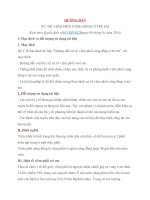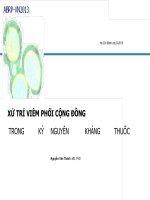Tài liệu_XỬ TRÍ VIÊM PHỔI CỘNG ĐỒNGTRONG KỶ NGUYÊN KHÁNG THUỐC
Bạn đang xem bản rút gọn của tài liệu. Xem và tải ngay bản đầy đủ của tài liệu tại đây (1.62 MB, 51 trang )
Ho Chi Minh city 9-2013
XỬ TRÍ VIÊM PHỔI CỘNG ĐỒNG
TRONG
KỶ
NGUYÊN
Nguyễn Văn Thành. MD; PhD
KHÁNG
THUỐC
MÔ HÌNH TỬ VONG
TOÀN CẦU (WHO 2004)
Mô hình tử vong toàn cầu 2004 (WHO)
Per cent
P•-r ceal
~
Deaths
Dtsea.., or.,,..,
(mjllon,I
World
lsdlaemic hean disease
2
Cerebro•-ascu lard isease
3
t.ewer re.spira tory inf ecnons
4
1
122
5.7
2
9J
CDPD
5
Diarrhoeal diseases
6
HIV/AIDS
7
7.2
4.2
7.1
3.0
5.1
2.2
3J
2.0
Tube rt.ulosls
8
Tra(hea., bro nc:hus., lung c:ance,s
9
Road t,afflcao::fdents
10
1.3
3
35
Prematurity and low b1rth weight
2
3
CDPD
9.4
Diarrhoeal diseases
1.8
1S
6.9
HIV/AIDS
5
Cerebreva scubr disease
1S
6
COPD
0.9
7
Tubertulosls
1.3
2.3
8
t~~onar.al lnfecdons'
9
Malari.
1.2
11.2
2S
25
0.9
5.6
3.6
3.5
09
09
3.4
3.3
P~ma tu rit)' 1u,d IO'N birth Y1o-elght
10
2.0
5.7
l.2
0.8
Hl9'J+lnct1m• countMs
I
Cerebro ..-ascu lar d tsease
lsdlaemic hean disease
lschaemic heart disease
29
4
ltMddlr..lnaJm• countri•s
·1
LaNer respirator)' infections
1.5
2.2
deMhs
(rN•lon!I
Low-in
dNths
1
De,1ths
Dtsease or l•Ju'Y
lol•I
«
IOhl
3.4
1.8
3.5
2
13.9
3
7.4
4
4
lcrNer respiratory inf ecuons
09
5
Trachea., bronchus., lung cancers
0.7
6
Road traffic accidents
0.7
lschae.mic heart disease
1.3
16.3
0.8
9.3
03
3.8
14.2
Cerebro..ra scullr disease
Tracnea, bronchus., lung cancers
OS
5.9
lcrNer respirator;• infections
3.8
5
COPD
6
AJzheimerandother dementias
7
Colon and recmm cancers
2.9
3.5
03
3.4
03
2.8
03
3.3
Nhiễm
khuẩn
hô
nhiều nhất đi khám
180
165
160
140
1
120
80
60
Source: Verispan PDDA 2004
Số lần khám chủ yếu (đơn vị triệu lượt)
100
1
9
65
hấp
là
lý
do
75% các kê toa
kháng
sinh trên toàn thế giới là
dành cho Nhiễm khuẩn hô hấp
Anonymous (1998). Acute respiratory infections: the forgotten pandemic. Communique from the International Conference on
Acute Respiratory Infections, Canberra, Australia 7-10 Jult 1997. International Journal of Tuberculosis and Lung Disease 2,
2-4.
V ệt Nam 2009
Siingapore
Nguồn: WHO - Asia
2009
TABLE 1. Incidence
of specific
pathogens
in
pneumonia by site of care
community-acquired
AMBULATORY
NORMAL
INTENSIVE
WARD
CARE UNIT
Pathogen
No yield
45.9-50o/o
Streptococcuspneumoni
Streptococcuspneumoniae
32.9%-48.7%
34-38°/o
27-48%
Haemophi/us influenzae
3-13°/o
Mycoplasma
Mycoplasmapneumoniae
8-23%
6-7°/o
Bochud PY, Moser F, Erard P, et al. Community-
9-21°/o
acquired pneumonia: a prospective outpatient study. Medicine (Baltimore) 2001;80(2):75-87
Lim WS, Macfarlane JT, Boswell TC, et al. Study management guidelines. Thorax of community acquired pneumonia aetiology (SCAPA) in adults admitted to hospital: implications for
2001;56(4):296The aetiology, management and outcome of seve
Committee and The Public Health Laboratory Service. Respir Med 1992;86(1):7-13
301
re community-acquired pneumonia on the intensive care unit. The British Thoracic Society Research
14-28%
7-12%
3-22%
Chlamydophilapneumoni
ae
45-48%
4°/o
2-7%
Câu hỏi 1.
Tình hình
kháng
thuốc
Tình
hình
Thấp (<10%)
Ý
Đức
S pneumoniae
Trung bình (10-30%)
Irland
Bồ Đào Nha
Anh
Hungary
Thụy Sỹ
Canada
Benelux
Scandinavia
Ác-hen-ti-na
kháng
PNC
Cao (>30%)
Pháp
Tây Ban Nha
Cộng hòa Slovac
Bungari
Rumani
Brazin
Thổ Nhĩ Kỳ
Bắc Phi
Isreal
Mỹ
Pê- ru
Arập Saudi
Mê-hi-cô
Kenia
Bắc Phi
Nigeria
Thái Lan
Philippines
Nhật bản
Singapore
Hàn Quốc
Australia
Đài Loan
New Zealand
Hồng Kông
Việt Nam
F. Paradisi et al. 2001 CMI. 7 (S 4). 34-42.
Kháng
của Pneumococi với
ANSORP
penicillin
∼ 2001)
(1996
80
: :J
0,
E
N
"
•
•
•
70
60
J\J
u
~
2
50
(J)
c
40
~
v i
-
c
Clinical
isolates (1996-1997)
Carriage isolates (1998-1999)
Clinical isolates
(2000-2001)
30
;;;
(J)
20
a,
c
:
c..
~0
u
c
I ~
10
0 ~
~
~..
't ....
0
..,,
,,'=?,
a,
Song JH & A160RP. Antirmcrob Agents Chemother. 48;2101,2004
-·
,>.
't
~
~
~
~
t
~'9
1
~
~
%,
~
~
-:,..,,
~
~
~<>
I
~-
di~
~
~
o,..
0
v. d' ,.
~
< ~,;;,
..,,
~
..,,
~~ a;,
'::>-:,<
<;)
I_
~
1,.
~
~-
4%
'?
0
d'
o
~
S.PNEUMONIAE
KHÁNG
THUỐC
S.PNEUMONIAE
(SOAR VIET NAM 2011)
95.3
100
94
96.2
86.8
90
82.6
.
80 9
80
72.8
70
60
50
40
30
2
0
1
0
0
0 ~
(SOAR Viet Nam 2011)
.
ANSORP News: A multicenter study on antibiotic resistance of 204 S. pneumoniae in Vietnam
B-lactam resistance in pneumococci: Asia
MIC90
(mg/L)
Country
Penicillin
Vietnam
4
8
Amoxicillin
8
Cefuroxime
Ceftriaxone
2
Korea
4
4
8
1
Hong Kong
4
2
8
1
Taiwan
4
2
8
1
2
2
8
1
Thailand
Data from the multinational surveillance study clearly documented distinctive increases in
Singapore
2
1
4
the prevalence rates and the
levels of antimicrobial
resistance
China
2
4
among S. pneumoniae isolates
in many2Asian countries,
which are 1among the highest in
Malaysia
Philippines
the world published to date.
2
0.25
0.03
1
2
4
1
0.03
0.25
0.25
< 0.03
0.12
< 0.25
India
* ANSORP data (2000-2002)
Song JH & ANSORP.
Antimicrob Agents Chemother. 48;2101,2004
Invasive
pneumococci: resistance to
fluoroquinolones
(2000–2001)
(%) Resistance
ANSORP
®
~
")
*685 isolates
\
®
®
~~~
t~
i '
'
~
,. ~>
,·:?
~
>
'
'
.
~% ~,
~
Song JH & ANSORP. Antimicrob Agents Chemother June 2004, p. 2101–2107
~
®
®
~~
~~~
~~
'@
~
Evolution of FQ Resistance among
Pneumococci
•
•
Levofloxacin resistance
- 1995:
< 0.5%
- 1998:
5.5%
- 2000:
13.3%
LR% in pen R
Sử dụng FQ ở HK
in Hong Kong
(MIC >4
strains
µg/ml)
- 27.3%
Ho, et al, JAC 48:659, 2001
Summary
Resistance
: clinical
impact
Resistance
Major
of pneumococcal
Clinical
Clinical
resistance
antibiotic class
Rate / MICs
relevance
areas
failures
Penicillins
Cephalosporins
Macrolides
in RTI therapy
/
Asia
variable
Asia
/
Asia
Very few
Few
Increasing
Reports
Fluoroquinolones
/
Asia
Few
(HK)
(levofloxacin)
Not significant
Not significant
Relatively
significant
Undetermined
H. influenzae tạo beta-lactamase
% chủng beta-lactamase [+]
Quốc gia
(Số chủng)
H. influenzae
Korea (51)
64.7
100
Hong Kong (41)
17.1
100
Japan (281)
8.5
96.7
France (193)
31.1
97.3
USA (276)
25.7
94.1
M. catarrhalis
Resistance
70%
Intermediate
4%
60%
Ac
Amoxicillin-
60%
clavulanate
50%
Cu
40%
7%
Cefuroxime Cefaclor
Cr
Ampicillin
Am
Azithromycin
49%
48%
Az Bt
30%
Sulphamethoxazoletrimethoprim
BLM
20%
β-
lactamase production
0%
10%
0%
1%
8%
0%
0%
8%
0%
Ac
Cu
H.
influenzae
multicenter
(P.H.Van et al, 2005)
Cr
Am
with
antibiotic
study in HCMC,
Az
Bt
resistance:
Vietnam
BLM(+)
H.
Influenzae
kháng
thuốc
H.INFLUENZAE
(SOAR VIET NAM 2011)
100
90
83
•R •I
88.4
80
70
68.8
60
50
43.8
40
30
20
10
0
(SOAR Viet Nam 2011)
•S
M.pneumoniae
< 16 tuổi
16-19 tuổi
kháng
macrolide
> 20 tuổi với CAP
Miyashita N et al. Int J Antimicrob Agents 2010, 36(4): 384–385.
Fifty-three Mycoplasma pneumoniae strains were
isolated from pediatric patients in Shanghai
Distribution of MICs of 10 antimicrobial agents for 53 M. pnewnoniae strains
No. of strains with MIC (µgiml) of:
Antimicrobial
~0.007
0.015
0.03
0.06
0.12
0.25
0.5
2
4
8
16
32
64
128
>128
5
Erythromycin
Clarithromyci
4
4
6
3
n
Azithromycin
Josamycin
4
3
7
1
Tetracycline
1
Doxycycline
2
2
7
2
6
1
Ciprofloxacin
5
Levofloxacin
8
Yang
7
2
1
1
5
8
1
1
6
14
3
Liu et
2
3
0
1
11
1
2
6
1
10
2
1
7
27
6
7
Minocycline
Moxifloxacin
4
9
2
4
3
6
6
2
4
24
al., Antimicrobial agents and chemotherapy
May 2009
7
4
20
Time course of Mycoplasma pneumoniae (DNA copy number) in
the nasopharynx of nine patients with macrolide-sensitive M.
pneumoniae
pneumonia
before and after antimicrobial therapy
Y Kawai et al. Respirology (2012) 17, 354–362
.
copies
The
·1000000
microbiological
and
clinical
efficacies
of macrolides for treating patients with MR M. pneumoniae pneumonia were
low. These results show that macrolides are clearly less effective in patients
with MR M. pneumoniae pneumonia.
100000
MCL T3
10000
MNC T3
1000
100
10
1
Before antimicrobial
48 h after
End of
treatment
antimicrobial
antimicrobi
Comparison of children with community-acquired pneumonia and
macrolide-resistant and
macrolide-sensitive M.
pneumoniae infection
Result
Outcomes during macrolide
Macrolid~resistant
treatment
1W;
pneumoniae (n =
~)
MacroIidesensitive
M pneumoni,ie =
(n
Pvalue
J~)
Total no. of feorile days, median (range)
7 (~lJ)
No. of febrile days duru1g macrolide admu1istrationi median (range)
4 (1.. IQ)
15 (l..J)
O.OJ
No. of days with cough during macrolide administration, meaian (range)
, (1.. 14)
2(1..it)
0.04
No. of patients with a feorile period 4~ l1 after macrolide aaministration
7 (~15)
1 (JJ)
<0.000
7 (~15)
IO (16J)
10 (1-J1)
4 (1-20)
W (l,--
14
46)
(10..21)
(%)
No. (%) of patients with a cl1ange of prescription after macrolide
aaministration
Median duration of hospitafaatio111 days (range)
Fabio
Cardinale
et al. (Italy).
Journal of Clinical
Microbiology
Median
duration
of antibiotic
therapy,
aays 2013. 51 (2): p. 723–724
4 (1.. IQ)
036
1
0.002
O.OJ
0.02
Community-Associated
MRSA
•
Four pediatric deaths 1997-1999 in Minnesota
•
North Dakota (MMWR 1999;48:707)
–
Predominantly skin and soft tissue
Clinical manifestations
• 59% of purulent SSTI in 11 ED, 78% of S.
•
–
Necrotizing fasciitis
–
Necrotizing pneumonia
aureus
Different from HA-MRSA
–
SCCmec type IV
–
Panton-Valentine Leukocidin exotoxin associated with tissue necrosis and leukocyte destruction (or
other toxin?)
JAMA 2003;290:2976-2984
and
Community-acquired methicillin-
S.
resistant
aureus
Pneumonia
80
20
18
70
16
60
14
-
c:
50
12
v,
n
Q)
v,
ca
40
10
ct
(.)
8
Q)
er
·2::::,
~
30
:::,
6
20
4
10
2
0
0
2000
2001
2002
2003
2004
2005
Rajesh Thomas et al. Respirology (2011) 16, 926–931
2006
2007
2008
en
0:::
:E
Câu hỏi 2.
Mục tiêu của Kháng sinh trị liệu?









